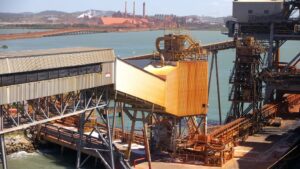Alumina, the raw material for aluminum production, is derived from bauxite ore through a complex refining process. This processing can create significant levels of dust, fumes, and heat, so effective industrial ventilation design is essential. With reliable ventilation systems in place, workers are protected from these potential health hazards.
Our experienced team can develop efficient ventilation system designs for alumina processing facilities. Contact us for a system assessment and design quote today.
What is Alumina?

Aluminum and alumina, while closely related, are distinct substances with vastly different properties and applications. Aluminum is a silvery-white, lightweight metal renowned for its strength-to-weight ratio, ductility, malleability, and corrosion resistance. It’s used extensively in countless industries, from aerospace and construction to packaging and electronics.
Alumina, on the other hand, is aluminum oxide (Al2O3), a hard, chemically stable, white or nearly colorless compound. Unlike aluminum metal, alumina is an excellent electrical insulator with high heat resistance.
These properties make alumina invaluable in various applications, including:
- Abrasives: Alumina’s hardness makes it ideal for use in sandpaper, grinding wheels, and cutting tools.
- Refractories: It withstands extremely high temperatures, making it a vital component in furnace linings and insulation materials.
- Ceramics: Alumina is a key ingredient in advanced ceramics used in electronics, medical implants, and other high-performance applications.
- Catalyst Support: Alumina’s porous structure and high surface area make it a valuable material for supporting catalysts in various chemical processes.
Key Challenges in Alumina Processing Ventilation
The processing of alumina involves several steps that generate hazardous dusts and fumes, so efficient ventilation is crucial throughout the entire process. Various refining stages, such as calcination and digestion, release harmful fumes. These contain corrosive substances that pose severe health risks if not properly extracted. An appropriately designed industrial ventilation system captures these harmful substances at their source, removes them from the work environment, and replaces contaminated air with fresh air.
During the process, bauxite ore is crushed and undergoes digestion under high temperatures and pressure, releasing corrosive vapors. Precipitation and calcination further produce fine alumina dust. Inhalation of these fine particles can cause chronic respiratory issues and lead to dust explosions under certain conditions.
In addition, the high temperatures used throughout alumina refining generate significant heat. Exhausting this heat helps maintain worker comfort and protects equipment to extend its lifespan.
Critical Considerations for Ventilation System Design
Alumina processing facilities need to employ a mix of ventilation strategies, including both general and dilution ventilation. Meticulous calculations are needed to guide airflow, hood design, and ductwork placement. This will maximize contaminant removal efficiency.
General ventilation involves a balanced system of supply and exhaust fans. Supply fans bring fresh outdoor air into the workspace, while exhaust fans remove contaminated air. This dilutes the overall concentration of pollutants within the entire area. General ventilation is useful in areas where contaminants are dispersed throughout the facility or it’s not feasible to capture pollutants directly at their source. It helps manage background contamination levels, odors, and moderate heat build-up.
Dilution ventilation specifically focuses on introducing a substantial volume of fresh air to dramatically reduce the concentration of airborne pollutants. The effectiveness of this system depends on adequate mixing of fresh air and contaminated air. This type of ventilation alone is mostly used when the contaminant generation rate is relatively low and the substances released are less hazardous, but can be combined with general ventilation components for a more comprehensive approach.
Common Ventilation Components for Alumina Processing
The ventilation equipment used in alumina refining needs to be able to withstand a harsh environment. For example:
- Fans must be robust and able to handle potentially corrosive fumes and abrasive dust.
- Ductwork needs to be constructed from materials that resist chemical attack and internal build-up.
- Filtration plays a crucial role, with baghouse filters commonly used for capturing large volumes of alumina dust.
- Air scrubbers may be necessary to remove corrosive substances from fumes.
- Air cleaning technologies, such as electrostatic precipitators, can also be used for additional particulate removal.
Regulatory Compliance and Best Practices
OSHA and ANSI set stringent regulations for ventilation in industrial processing facilities. Complying with these standards is essential for worker safety and avoiding regulatory penalties. For alumina processing, the relevant standards include:
OSHA Standards:
- 29 CFR 1910.1000 – Air Contaminants: Sets permissible exposure limits (PELs) for various dusts and fumes generated during alumina processing.
- 29 CFR 1910.94 – Ventilation: Outlines general ventilation requirements for different industrial settings.
- 29 CFR 1910 Subpart Z – Toxic and Hazardous Substances: Contains additional provisions for process safety and control of hazardous chemicals.
ANSI Standards:
- ANSI/AIHA Z9 Series: Provides guidelines for ventilation system design and performance in various industrial environments.
Expert Ventilation System Design from Eldridge
The right industrial ventilation system design in an alumina processing facility helps protect the health and well-being of workers while maintaining a safe and compliant environment. Modern ventilation systems incorporate energy-saving features to help reduce operating costs. This could include variable frequency drives on fans and heat recovery systems. There is also the possibility of integrating sensor networks and automation. This allows real-time monitoring and adjustments to your ventilation system, optimizing performance and responding to changing conditions.
Since 1946, we’ve specialized in designing ventilation systems tailored to the unique dust, fume, and heat challenges of alumina production. Our solutions prioritize efficiency and compliance, leveraging the latest technologies. Rely on our expertise in ventilation systems; contact us for a technical assessment and design quote now.
